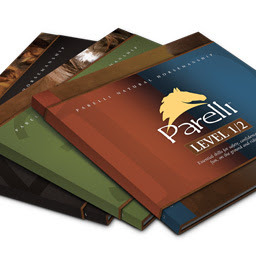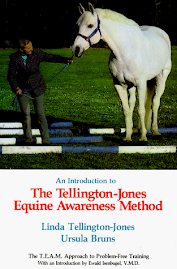There is a lot to learn from the re-education of damaged horses simply because the re-education is exactly that which, if done initially, would have allowed the horse to perform to his full potential and remain sound. In many instances, sou...ndness could be restored, and horses could return to a successful life. Very few though, are given a chance because it is difficult for the rider to face the thought that one may have caused the problem. The guilt is misplaced. In most instances, it is not one’s skill or lack of skill that lead the horse to lameness but rather the system that emphasizes riding and training principles unrelated to the horse’s physiology.
James Crook wrote, “A man who wants to lead the orchestra must turn his back on the crowd”. Once again, the metaphor applies to the horse. The system wants you to believe that equine athletic performances can be enhanced by increasing the amplitude of the horse vertebral column’s movements. In reality, while in motion, the range of movement of the equine spine is very limited and the primary function of the back muscles is precisely to protect the vertebral column’s structure from any amplitude of movements which would exceed the vertebral column’s possible range of motion. Efficiency is not about greater amplitude of vertebral column movements but rather better orchestration of numerous but minuscule muscle contractions and compensatory contractions.
When a horse is crippled as a result of having been trained deep and low, and heavily on the forehand, soundness cannot be restored by working the horse lower and more forward. The problem is that by questioning the theory, one stands against the crowd. The thought might be scary at first, but after all, if one truly likes music, it is more pleasant to face and direct skilled artists that are creating the music than to face a crowd that is quick to criticize but does not have any idea on how to play the violin.
The horse is a skilled artist, which by nature and also by intelligence enjoys using his physique. Comfort is a main concern of the horse’s self preservation instinct and performing at ease is naturally more attractive for the horse than under painful constraints. If one truly loves the horse, the pleasure of a performance achieved in great harmony and ease and accuracy and soundness, is unmatchable even if the blue ribbon goes to someone going faster, riding a horse addicted to anti-inflammatories and hyaluronic acid.
Molly Ivins says, “The first rule of holes: When you’re in one, stop digging”. Walter Zettl wrote, “Ride your horse into heaven and not into the ground”. When your horse is in the hole, stop digging his grave. Heaven is higher and I do not refer solely to the neck posture but also to the rider’s standards. Look at what needs to be done to allow a horse once driven into a hole to breathe again and you will understand how to educate your horse in the first place.
Judging standards, riding principles, training techniques, books, practical application of scientific findings, and panel discussions all follow the thought that the horse’s lower line, which includes abdominal, pectoral, and neck muscles, flexes the horse’s upper line, the vertebral column and surrounding muscles. We have explored instead the thought suggested by Richard Tucker and James Rooney, as well as that in the works of Leo Jeffcott, Jean Marie Denoix, Kevin Haussler and many others. Also considered were the researches based on dynamics models that were executed by Anton J. van den Bogert and many others. The working hypothesis was that while the muscles of the horse’s lower line are definitively involved in locomotion and athletic achievements, their influence on the horse’s vertebral column are elementary, and therefore ill adapted to the sophistication required by modern performances. Instead, the muscular system situated directly above the vertebral bodies has the capacity to orchestrate the vertebral column mechanism at a higher level of sophistication.
This muscular system is extremely complex and cannot be efficiently influenced by acting, at one end on the engagement of the hind legs, and at the other end on the neck posture. It was then necessary to figure how the rider could access and influence the horse’s vertebral column’s biomechanical properties. The Science of Motion response comes by combining an actual understanding of the vertebral column mechanism and the teaching of great masters. The biokinematics of the equine vertebral column, and consequently the kinematics of the limbs, (quality of the gaits) and the horse’s ability to perform at its utmost potential, while remaining sound, can be influenced by the biomechanical properties of the rider’s vertebral column.
This is a fundamentally new approach and of course like everything new, we are encountering panic and heavy resistance. Panic results from the fact that the most aggressive opponents know deep in their mind of the short cuts of their beliefs and their application and are afraid to face the thought that they might have to evolve. The response to skepticism is the horse’s soundness. Correct orchestration of the horse vertebral column properties not only allows the horse to perform better and remain sound, but re-educations once not even considered are now truly possible. Lameness issues that cannot be solved through traditional and alternative therapies can be resolved by acting on the source of all body movements, the horse’s vertebral column.
We document these impossible re-educations and publish the documentation in DVD format once the re-education has been successfully completed. The DVDs contain pertinent but proven information. The horse was lame and the horse is now sound. The horse was a mediocre mover and turns into a world class athlete. The horse cannot piaff and he does. The horse cannot jump the water and he jumps the water. There is no cure for kissing spine and the ‘kissing spine’ horse returns to normal life and performances. Jean Luc Cornille/Science Of Motion
Gretchen Rubin’s 2025 Gift Guides
1 week ago






























































Wow! Just wow! Is this a book? I want more!
ReplyDelete